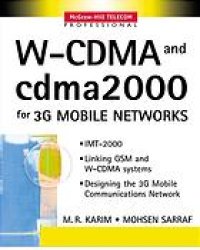
Ebook: W-CDMA and cdma2000 for 3G mobile networks
- Series: McGraw-Hill telecom professional
- Year: 2002
- Publisher: McGraw-Hill
- City: New York
- Language: English
- pdf
As service providers start to build third-generation and umts networks, they need a wizard to make sense of elaborate protocols and out-of-context technology reports. "Excellent coverage: captures the gamut from propagation science to network planning." - Nikil Jayant, John Pippin Chair in Wireless Systems, Georgia Tech. "For those already installing 3G systems, I recommend it be rushed into print." - Reed Fisher, Read more...
Abstract: As service providers start to build third-generation and umts networks, they need a wizard to make sense of elaborate protocols and out-of-context technology reports. "Excellent coverage: captures the gamut from propagation science to network planning." - Nikil Jayant, John Pippin Chair in Wireless Systems, Georgia Tech. "For those already installing 3G systems, I recommend it be rushed into print." - Reed Fisher, formerly of Bell Labs and father of the cell phone. "Engineers will find this is a much-needed integrated approach to understanding 3G technologies." - Ken Smolik, Technology Specialist, Banner & Witcoff, Ltd. This book gives network managers and 3G workers a select background in spread spectrum technology, empowering them to make real-world design, purchasing, and deployment decisions. Assuming only that W-CDMA is the preferred interface, the authors make a point of grounding 3G technologies in the fundamentals of propagation characteristics, physical layer functionalities, and spectrum requirements, so readers can confidently tackle soft handover, power control, sectorization, and message flows.; Written by authors with deep experience in data communications design and development, this jargon-free look at W-CDMA: spells out what providers must know to enable wireless data speeds 40 times the current level; shows how to integrate U.S., European, and Pacific Rim flavors of 3G for worldwide roaming access; explains how spread spectrum functions best in data transmission; covers vital links between GSM and W-CDMA systems; and reviews and unpacks IMT-2000 interface proposals. Worth its weight in paid consultants to wireless carriers, service developers, systems engineers, and telecom managers, this book opens a window on the implications of the air interface in the next-generation network